Scaling agile refers to bringing Agile practices such as work visualization, alignment between projects and goals, and coordination at the enterprise level.
What Is Agile at Scale?
Agile at scale extends the Agile mindset with its principles beyond individual teams, applying them across multiple layers of an organization. It ensures that agility is embedded at every level, from team to leadership, enabling a value-driven and adaptable business environment.
Scaling Agile requires more than just adopting frameworks - it demands a cultural shift that fosters collaboration, transparency, and responsiveness to change. To succeed, organizations need a structured approach that aligns team-level execution with high-level strategy.
Why Implement Agile at Scale?
While Agile practices applied locally were revolutionary just a few years ago, today, companies need to scale that agility across and create connected systems to improve their efficiency, collaboration, and adaptability.
Key Benefits of Scaling Agile:
✅ Bridges the gap between strategy and execution
✅ Enhances collaboration across teams and departments
✅ Improves adaptability, allowing for quick strategy shifts
✅ Increases predictability in value delivery
✅ Ensures continuous value creation for customers
The Challenges of Implementing Agile at Scale
While spreading the agile values offers numerous benefits, organizations often encounter significant hurdles during implementation. Successfully transitioning to enterprise-wide agility requires overcoming these key challenges:
1. Resistance to Change: Employees may resist change and need help to adapt to new roles, responsibilities, and ways of working.
2. Lack of Collaboration: Agile requires collaboration and communication between teams, departments, and stakeholders. Without a culture of collaboration, the implementation of Agile may fail.
3. Inconsistent Adoption: Different teams may adopt Agile at different speeds or with different levels of commitment, leading to inconsistency in practice and results.
4. Scaling Agile Practices: Implementing Agile at scale requires significant coordination and planning to ensure that all teams are aligned and working towards the same goals.
To overcome the challenges and succeed, many organizations turn to scaling frameworks. Let’s explore some of the most popular approaches for agile adoption at scale.
The 5 Most Popular Tools for Scaling Agile
To address these challenges, enterprises often turn to scaling frameworks designed to streamline Agile implementation at scale. Let’s explore some of the most widely used Agile scaling frameworks for large organizations.
1. Kanban- Led Models
Thanks to its evolutionary nature, the Kanban culture and practices can be a great fit for scaling agile. Kanban-led models empower data-driven decisions without disrupting established processes or roles. Methods such as KMM and Portfolio Kanban are great tools for organizations seeking to adopt and boost their organizational agility.
1.1 Kanban
Kanban is a workflow management method that helps organizations gradually enhance processes and efficiency through continuous improvement. The Kanban’s strength lies in its practices, such as visualizing the flow of work, limiting work in progress, and spotting bottlenecks while respecting existing workflows. While often perceived as team-level tools, these Kanban practices are equally effective organization-wide. With the help of multiple Kanban boards, teams can connect value streams across the organization, shifting the focus from single-team improvements to overall optimizations.
A testament to Kanban’s impact, Encoparts boosted operational efficiency by 33% in its international purchasing division through value stream mapping. By visualizing workflows, eliminating waste, and leveraging a BPM system, the company streamlined processes and made data-driven decisions for significant improvements.
Businessmap is the most flexible software
to align work with company goals
1.2 Kanban Maturity Model
The Kanban Maturity Model (КММ) is a process-level improvement model that promotes agility through the Kanban method. It defines the level of organizational maturity and shows what actionable steps are required toward a successful Kanban implementation at each maturity level. The KMM model helps teams, departments, and entire organizations to gradually advance their Kanban knowledge by moving from one level to another.
Take the case of Boa Vista, a financial solution provider, who trusted the KMM to empower their digital transformation. Their journey resulted in faster project execution and enhanced visibility into their business processes across all levels. Specifically, they utilized multi-layered kanban boards to drive transparency, align strategic goals, and minimize delays.
Read the full case study
2. Scaled Agile Framework (SAFe)
SAFe is a framework that empowers organizations to adopt the Agile way of working at scale. Based on the Agile principles and values, the framework provides structured guidance on how to plan and manage work better, improve collaboration, and deliver products faster. SAFe incorporatesseveral practices and principles for creating a working culture where the decision-making process and Agile way of thinking are promoted among everyone in the organization.
3. Large-Scale Scrum (LeSS)
The Large-Scale Scrum (LeSS) is a product-development framework that focuses on applying Scrum's principles and practices in the most straightforward manner possible. At its heart, LeSS supports the minimalistic concept (fewer roles, events, management, etc.), and scaling should follow this pattern to drive successful Agile deployment. This method is used by multiple cross-functional teams working together on the same product within a common Sprint.
4.Scrum@Scale (SaS)
Scrum@Scale, as a scaling framework, is a natural extension of the Scrum method. It works around the idea of coordinating multiple teams’ efforts toward achieving common business goals in complex environments while rolling out agility across the entire organization.
5.Spotify Model
The Spotify model represents a work structure the company created to scale its adoption of Agile across the organization. This model stresses creating an environment of enhanced collaboration and transparency across multiple product development teams and improved product delivery process.
The Spotify model is built around a specific structure of Agile product development teams that consists of the following key elements: squads, tribes, chapters, guilds, alliances, and trios.
While there is nothing wrong with investing in a framework that best fits your team and organization, it could turn out to be very cumbersome and expensive in the long run.
7 Key Principles for Scaling Agile Successfully
There’s no one-size-fits-all approach to achieving organizational agility, but certain core principles are essential for success. Whether adopting a framework or customizing Agile practices, these guiding principles help ensure a smooth and effective transition.
1. Define Clear Roles & Adapt Organizational Structure: Ensure clarity in roles, responsibilities, and workflows to create a structured yet flexible Agile environment.
2. Build a Customer-Centric Organization: Prioritize customer value at every level, fostering a culture that aligns work with customer needs and expectations.
3. Maintain Consistency in Agile Practices: Implement Agile principles and cadences across teams to drive efficiency, alignment, and continuous improvement.
4. Allow Time for Adoption & Maturity: Scaling Agile takes time. Organizations must recognize the learning curve and incremental improvements required for long-term success.
5. Improve Dependency Management: Identify and address cross-team dependencies to enhance workflow efficiency and eliminate bottlenecks.
6. Secure Buy-In from All Levels: A successful Agile transformation requires support from leadership and engagement from teams, ensuring top-down alignment and bottom-up participation.
7. Focus on People, Lean Principles & Systems Thinking: Agile thrives when teams embrace collaboration, Lean methodologies, and a systems-thinking approach to drive innovation and adaptability.
Implementing Agile at Scale: Practical Guide
Scaling Agile successfully requires more than just expanding team-level practices. It demands a holistic approach that seamlessly connects strategic vision to day-to-day execution. Moving beyond isolated Agile teams to achieve organizational-wide agility involves implementing an integrated strategic management system.
Using such a platform supports visualization of the entire process and improves predictability via regular review and analysis, which also ensures data-driven decisions at every level.
Let’s break down the process into practical stages to understand better how to achieve enterprise agility.
1. Connecting Strategy to Operations with Interconnected Work Boards
Did you know that an estimated 67% of all well-polished strategic initiatives fail due to their poor implementation? Some common reasons for the high failure rate include huge gaps between strategy and operations and a lack of organizational transparency.
Map and Connect All Your Value Streams
The first step to scaling agility on a global level is to have a highly refined structure in place, tying up all your value streams together. In practice, this can happen with the introduction of interconnected work boards. You can use them to visualize all the organization segments, going from the highest strategic level down to the team level or vice versa.
For example, you can build a Master Board or a dedicated workflow within it that represents your company's business objectives. There, your aim should be to visualize your organization's high-level strategic initiatives and regularly revisit them to make sure you are moving in the right direction.
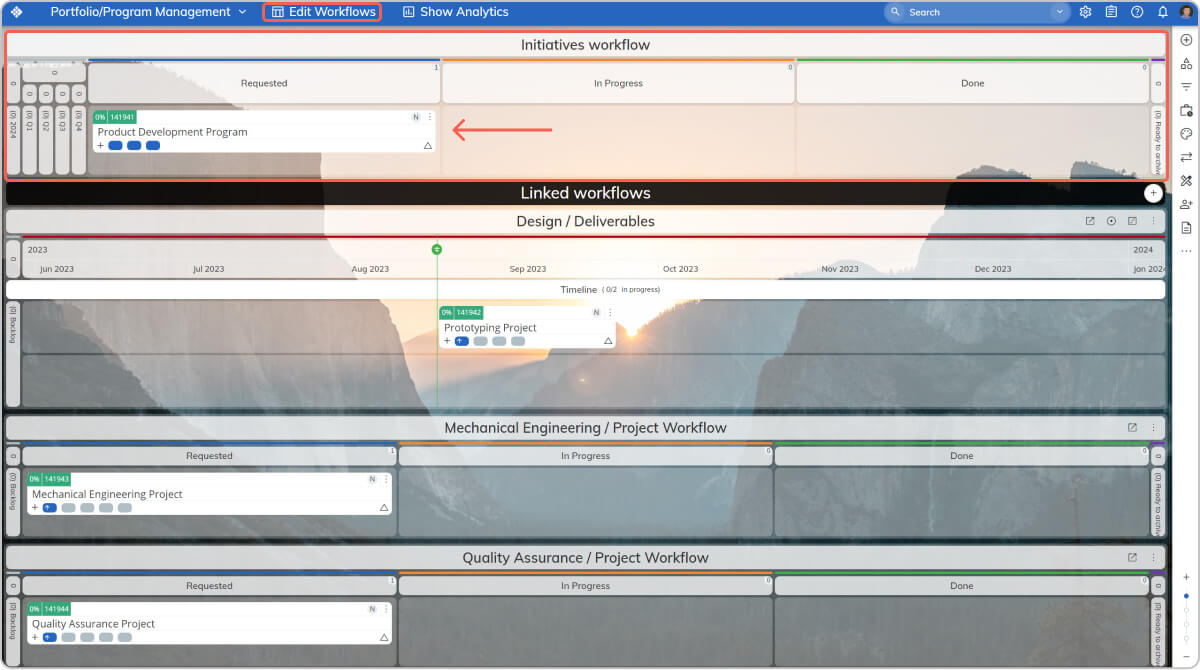 Connecting different value streams with the Linked workflows feature in Businessmap
Connecting different value streams with the Linked workflows feature in Businessmap
Senior managers can then engage in collaborative discussions and refine and break down those initiatives into a portfolio of separate projects that support the high-level vision. In turn, those projects can be further broken down into smaller deliverables (depending on their size) or directly linked to the specific teams responsible for their execution. To make this entire structure possible, you can use connected boards interlinked based on their hierarchy (ex. Strategy-Portfolio/Program-Project-Team).
Visualize All Team-Level Workflows
After establishing initial portfolio or project plans, the key is to allow teams to drive detailed execution within their own work management boards. By doing so, team members can visualize their specific workflows and break projects into granular tasks. In addition, teams collaboratively decide what to work on next, pulling new tasks as they complete existing ones.
Ultimately, the main idea of this iterative approach is to instill a sense of self-leadership within teams while allowing managers to focus on enhancing flow and eliminating bottlenecks.
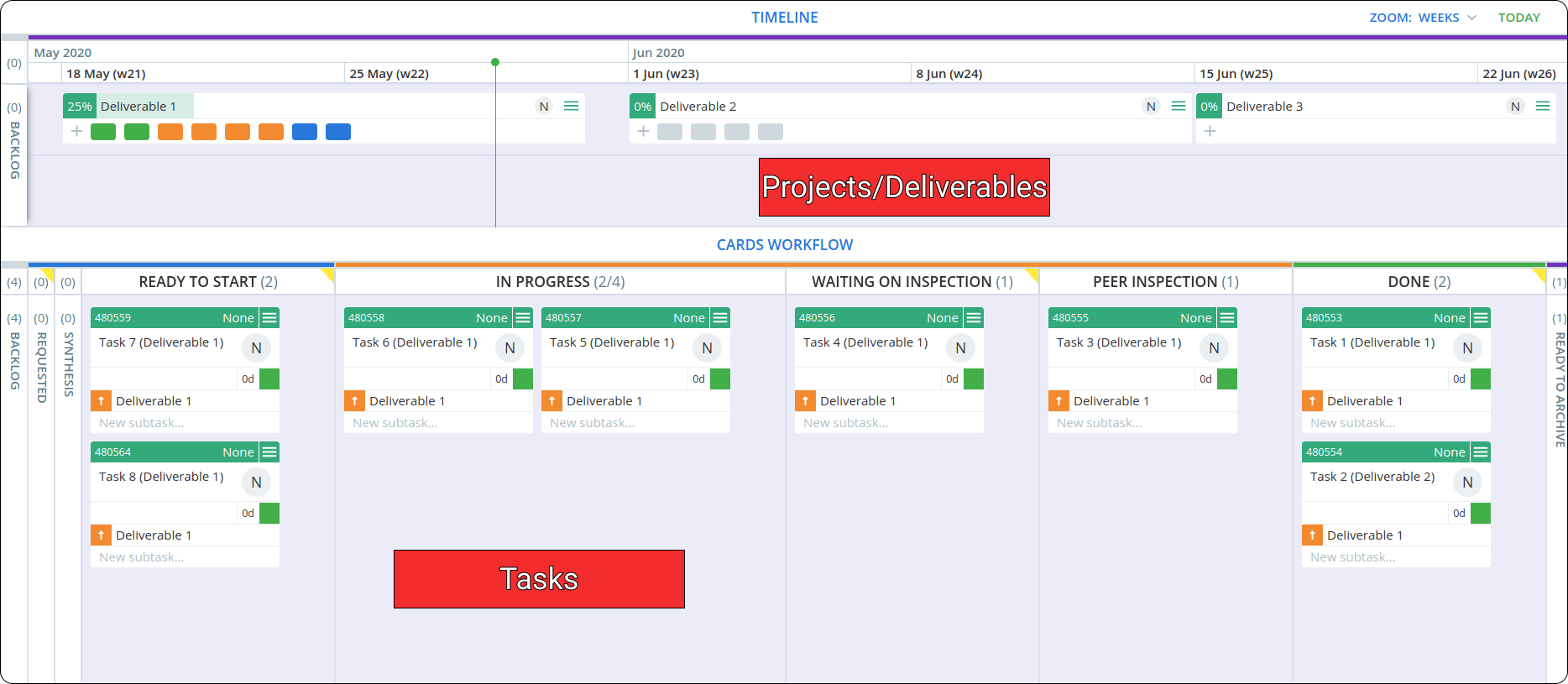 Breaking down projects/deliverables into manageable work items and visualizing them on a project management board in Businessmap
Breaking down projects/deliverables into manageable work items and visualizing them on a project management board in Businessmap
Using this entire structure of interconnected work management boards can help you translate your vision into practice and connect high-level objectives to their day-to-day execution. As a result, you will build transparency across the organization and be one step closer to scaling agility.
Businessmap is the most flexible software
to align work with company goals
2. Planning and Coordinating High-Level Initiatives
Another important point when scaling Agile across the organization is coordinating and planning the work on a global level. This can be done through regular feedback cadences. In general, those are meetings for aligning business communication that can help you regularly plan, review, and sync work progress to retain agility and adapt to changes whenever necessary.
Facilitating these meetings allows managers at every level to align and prioritize portfolios of projects with strategic company goals and focus on what matters most. Using interactive tools like Gantt charts makes it easy for everyone to coordinate work without losing track of its progress toward completion. Gantt charts provide an overall view of current and future initiatives. This enables capacity-driven planning, dependency mapping, progress monitoring, and flexible initiative adjustments.
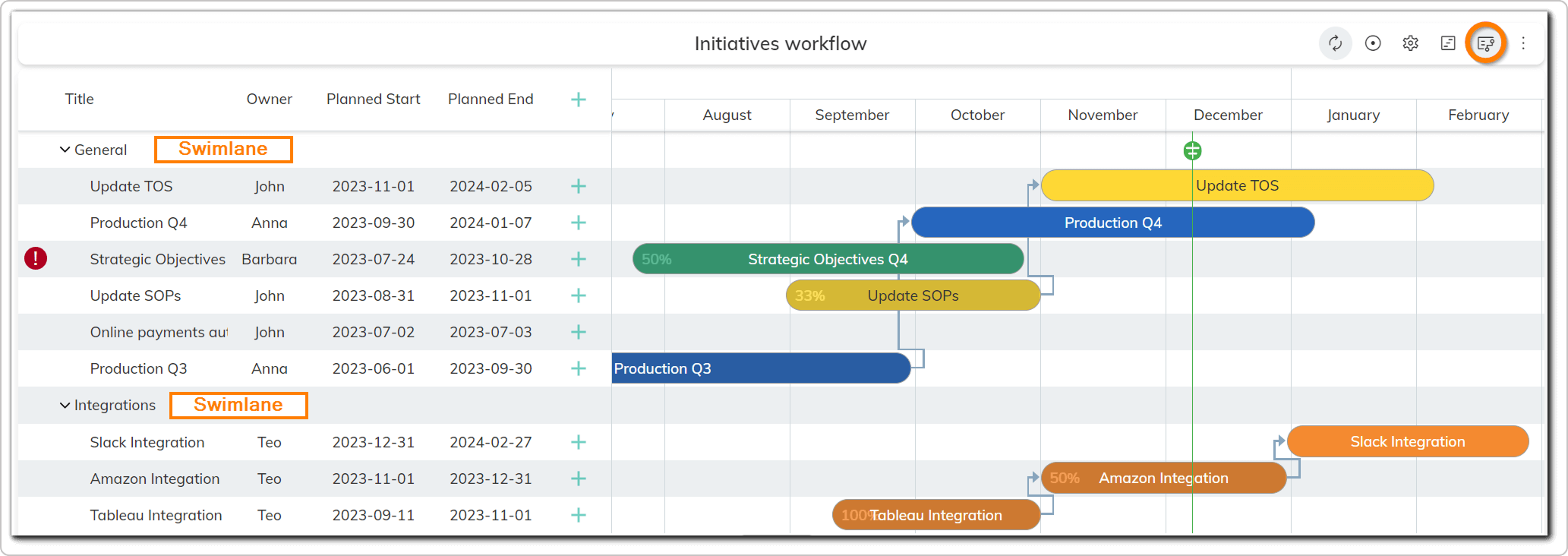 Visualizing project planning using the Planning view in Businessmap
Visualizing project planning using the Planning view in Businessmap
3. Managing the Flow of Work at a Global-Level
Transparency alone brings a lot of improvement to daily operations. However, scaling Agile is not the end point. That's because the main purpose of scaled Agile is to create synchronization between all organizational layers so that everybody is working on the right thing at the right time. That's why, apart from merely visualizing all work activities, you need to ensure that the work flows efficiently from concept to completion across the whole company.
Limiting Work in Progress Globally
One of the first steps is to limit WIP (Work In Progress) on a global level.It means governing the number of strategic initiatives and projects and defining the maximum amount of work that can exist in each status of the workflow in your organizational system.
This allows senior managers to ensure that what comes from a global position as a top priority will always be worked on by the teams and finished as soon as possible.
Introducing Commitment Points
Applying commitment points on a project/portfolio level is an excellent practice for managing global flow. These points validate when a work item is ready to be executed by the team and delivered to the end customer. This practice is not considered an internal promise for work to be done but instead follows a set of process policies that determine when a work item can be pulled into the system.
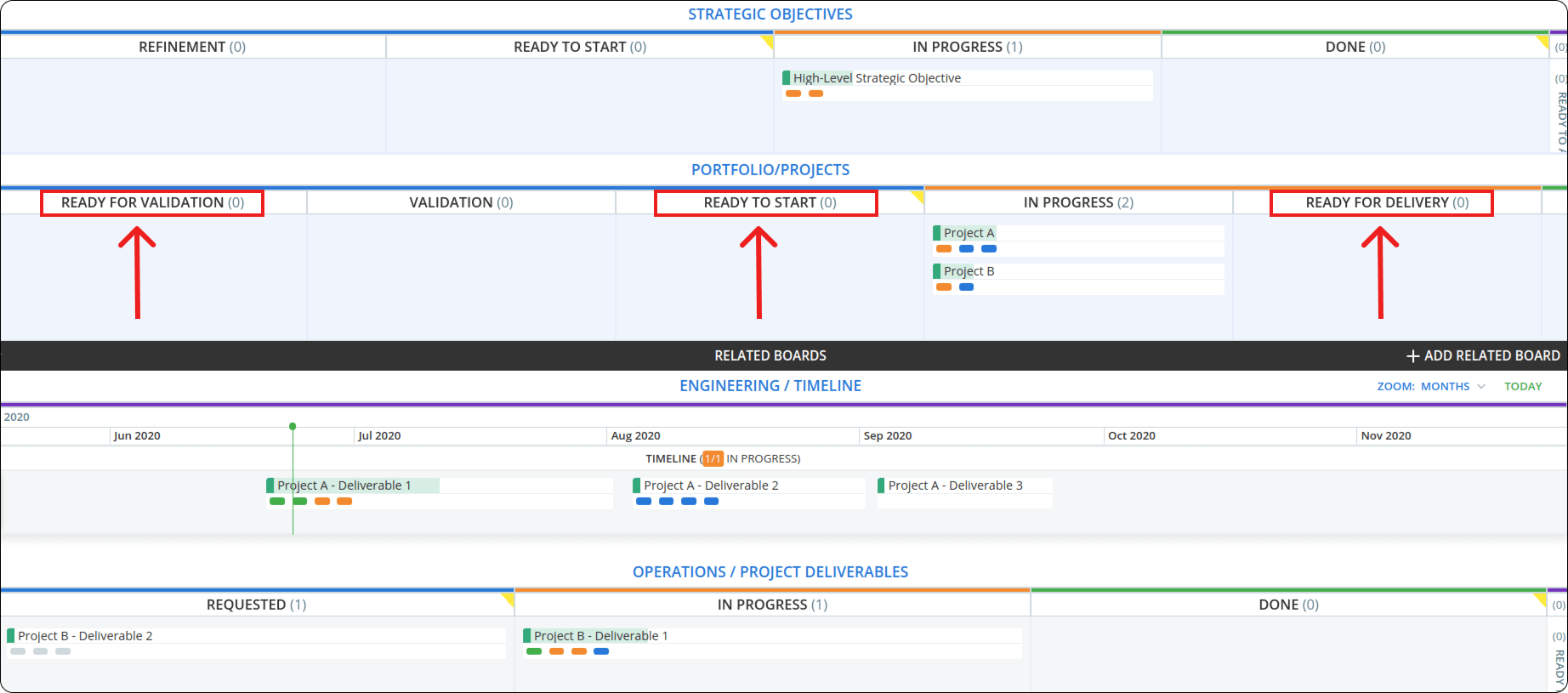 Visualizing commitment points on a portfolio board in Businessmap
Visualizing commitment points on a portfolio board in Businessmap
4. Tracking and Measuring Flow
Tracking metrics is another fundamental part of building and managing an organizational system that transforms operations into customer value while continuously improving.
Measuring cycle time, lead time, throughput and flow efficiency on a strategic or project level (apart from just separate work items on the team level) gives you the tools to analyze your system as a whole and look for ways to improve it.
With the introduction of Monte Carlo simulations, for example, you can take a probabilistic planning approach to projects or high-level strategic initiatives. Instead of estimating them based on your gut feeling, you will be able to forecast your delivery dates with greater certainty.
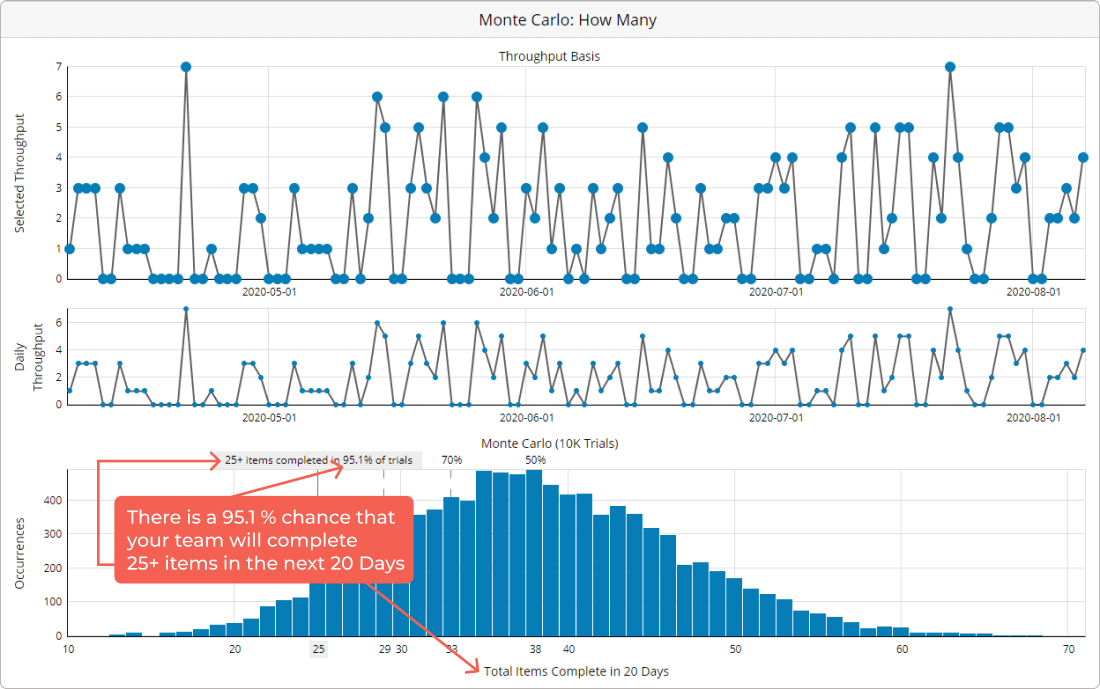 Example of Monte Carlo: How Manyin Businessmap
Example of Monte Carlo: How Manyin Businessmap
By consistently tracking these metrics, organizations can make informed decisions, identify areas for improvement, and ensure their Agile initiatives are delivering tangible results.
So, Where to Begin with Agile at Scale?
Whether to promptly respond to fast-changing market conditions, gain a completive edge, change organizational behavior, or drive digital transformation, agility can help you build that long-term resilience.
There is no right or wrong approach. You can do what many Agile companies do - use helpful techniques on your path to scaling Agile, or you can invent your custom holistic approach.
The foundation lies in prioritizing people, understanding your organization's specific needs, and implementing strategies that effectively scale and integrate Agile principles across all levels.
Here are a few simple strategies to follow:
1. Establish a shared vision and goals: Establishing a shared vision and goals across the organization is important to ensure that all teams work towards the same objectives.
2. Divide work into manageable chunks: Break down larger projects into smaller, more manageable pieces of work that individual teams can complete.
3. Implement a clear governance structure: Establish a clear governance structure to manage the flow of work, empower teams to make decisions and take ownership.
4. Emphasize collaboration and communication: Leaders should encourage open communication, transparency, and trust to foster a culture of innovation and learning. Organizations with a supportive and adaptable culture are better equipped to embrace Agile principles and practices and effectively scale their Agile initiatives.
Businessmap is the most flexible software
to align work with company goals





